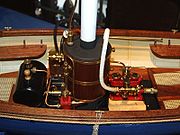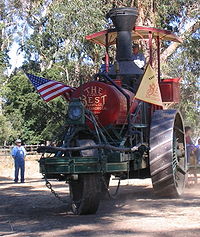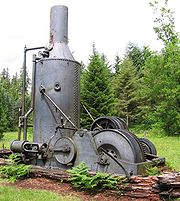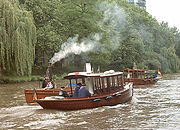
Vertical boiler
Encyclopedia

Fire-tube boiler
A fire-tube boiler is a type of boiler in which hot gases from a fire pass through one or more tubes running through a sealed container of water...
or water-tube boiler
Water-tube boiler
A water tube boiler is a type of boiler in which water circulates in tubes heated externally by the fire. Fuel is burned inside the furnace, creating hot gas which heats water in the steam-generating tubes...
where the boiler barrel is oriented vertically instead of the more common horizontal orientation. Vertical boilers were used for a variety of steam
Steam
Steam is the technical term for water vapor, the gaseous phase of water, which is formed when water boils. In common language it is often used to refer to the visible mist of water droplets formed as this water vapor condenses in the presence of cooler air...
-powered vehicles and other mobile machines, including early steam locomotive
Steam locomotive
A steam locomotive is a railway locomotive that produces its power through a steam engine. These locomotives are fueled by burning some combustible material, usually coal, wood or oil, to produce steam in a boiler, which drives the steam engine...
s.
Advantages
The main advantages of a vertical boiler are:- Small footprint – where width and length constraints are critical, use of a vertical boiler permits design of a smaller machine.
- Water-level tolerance – The water level in a horizontal boiler must be maintained above the crown (top) of the firebox at all times, or the crownplate could overheat and buckle, causing a boiler explosionBoiler explosionA boiler explosion is a catastrophic failure of a boiler. As seen today, boiler explosions are of two kinds. One kind is over-pressure in the pressure parts of the steam and water sides. The second kind is explosion in the furnace. Boiler explosions of pressure parts are particularly associated...
. For a vehicle application expected to traverse hills, such as a railway locomotive or steam wagonSteam wagonA steam wagon is a steam-powered road vehicle for carrying freight. It was the earliest form of lorry and came in two basic forms: overtype and undertype – the distinction being the position of the engine relative to the boiler...
, maintaining the correct water level when the vehicle itself is not level is a skilled task, and one that occupies much of the fireman's time. In a vertical boiler, the water is all sitting on the top of the firebox, and the boiler would need to be extremely low on water before a gradient could cause a risk by uncovering the firebox top. - Simpler (major) maintenance – A vertical boiler is usually mounted on a frame on the vehicle, allowing easy replacement. Horizontal boilers, such as those on railway locomotives and traction engineTraction engineA traction engine is a self-propelled steam engine used to move heavy loads on roads, plough ground or to provide power at a chosen location. The name derives from the Latin tractus, meaning 'drawn', since the prime function of any traction engine is to draw a load behind it...
s, form an integral part of the vehicle – the vehicle is literally built around the boiler – and hence replacement requires the dismantling of the entire vehicle.
Disadvantages
The main disadvantages of a vertical boiler are:- Size – The benefits of a small footprint are compromised by the much greater height required. The presence of over-bridges limits the height of steam vehicles, and this in turn restricts the size (and hence potential power capacity) of the boiler.
- Grate area – This is limited to the footprint of the boiler, thus restricting the amount of steam that may be produced.
- Short tubes – Boiler tubes must be kept short to minimise height. As a result, much of the available heat is lost through the chimney, as it has too little time to heat the tubes.
- Sediment – Sediment may settle on the bottom tube sheet (the plate above the firebox) insulating the water from the heat and allowing the sheet to burn out.
Applications




Railway locomotives
Several manufacturers produced a significant number of vertical boiler locomotives. Notable amongst these were:
- De WintonDe WintonDe Winton & Co were engineers in Caernarfon, Wales. They built vertical boilered narrow gauge locomotives for use in Welsh slate mines and other industrial settings. At least six De Winton locomotives have been preserved...
of CaernarfonCaernarfonCaernarfon is a Royal town, community and port in Gwynedd, Wales, with a population of 9,611. It lies along the A487 road, on the east banks of the Menai Straits, opposite the Isle of Anglesey. The city of Bangor is to the northeast, while Snowdonia fringes Caernarfon to the east and southeast...
who produced at least 34 narrow gaugeNarrow gaugeA narrow gauge railway is a railway that has a track gauge narrower than the of standard gauge railways. Most existing narrow gauge railways have gauges of between and .- Overview :...
locomotives, mainly for use in the slate quarriesSlate industryThe slate industry is the industry related to the extraction and processing of slate. Slate is either quarried from a slate quarry or reached by tunneling in a slate mine. Common uses for slate include as a roofing material, a flooring material, gravestones and memorial tablets, and for electrical...
of WalesWalesWales is a country that is part of the United Kingdom and the island of Great Britain, bordered by England to its east and the Atlantic Ocean and Irish Sea to its west. It has a population of three million, and a total area of 20,779 km²...
. - Sentinel Waggon WorksSentinel Waggon WorksSentinel Waggon Works Ltd was a British company based in Shrewsbury, Shropshire that made steam-powered lorries, railway locomotives, and later, diesel engined lorries and locomotives.-Alley & MacLellan, Sentinel Works, Jessie Street Glasgow:...
of ShrewsburyShrewsburyShrewsbury is the county town of Shropshire, in the West Midlands region of England. Lying on the River Severn, it is a civil parish home to some 70,000 inhabitants, and is the primary settlement and headquarters of Shropshire Council...
who produced a large number of shunters using their high-pressure vertical boilerSentinel boilerThe Sentinel boiler was a design of vertical boiler, fitted to the numerous steam waggons built by the Sentinel Waggon Works.The boiler was carefully designed for use in a steam wagon: it was compact, easy to handle whilst driving, and its maintenance features recognised the problems of poor...
s. These were mainly used on industrial railwayIndustrial railwayAn industrial railway is a type of railway that is not available for public transportation and is used exclusively to serve a particular industrial, logistics or military site...
s in Britain.
Steam lorries
The Sentinel Waggon WorksSentinel Waggon WorksSentinel Waggon Works Ltd was a British company based in Shrewsbury, Shropshire that made steam-powered lorries, railway locomotives, and later, diesel engined lorries and locomotives.-Alley & MacLellan, Sentinel Works, Jessie Street Glasgow:...
also produced a range of road lorries (steam wagonSteam wagonA steam wagon is a steam-powered road vehicle for carrying freight. It was the earliest form of lorry and came in two basic forms: overtype and undertype – the distinction being the position of the engine relative to the boiler...
s) based on their high-pressure vertical boilerSentinel boilerThe Sentinel boiler was a design of vertical boiler, fitted to the numerous steam waggons built by the Sentinel Waggon Works.The boiler was carefully designed for use in a steam wagon: it was compact, easy to handle whilst driving, and its maintenance features recognised the problems of poor...
s
Steam tractors
The Best Manufacturing CompanyBest Manufacturing CompanyThe Best Manufacturing Company of San Leandro, California was a manufacturer of farm machinery, now probably most well known for its steam tractors....
of San Leandro in CaliforniaCaliforniaCalifornia is a state located on the West Coast of the United States. It is by far the most populous U.S. state, and the third-largest by land area...
produced a range of steam tractorSteam tractorA steam tractor is a vehicle powered by a steam engine which is used for pulling.In North America, the term steam tractor usually refers to a type of agricultural tractor powered by a steam engine, used extensively in the late 19th and early 20th centuries.In Great Britain, the term steam tractor...
s that used vertical boilers.
Steam rollers
Certain designs of steam roller departed from the conventional traction engineTraction engineA traction engine is a self-propelled steam engine used to move heavy loads on roads, plough ground or to provide power at a chosen location. The name derives from the Latin tractus, meaning 'drawn', since the prime function of any traction engine is to draw a load behind it...
style of a horizontal boiler with an engine mounted above. Vertical-boilered rollers were built around a substantial girder frame chassis, with the boiler being mounted low down between the front and rear rolls. Such designs were not common in the UK.
Steam donkeys
The traditional form of steam donkeySteam donkeySteam donkey, or donkey engine is the common nickname for a steam-powered winch, or logging engine widely used in past logging operations, though not limited to logging...
(as a mobile winch used in the logging industry) married a vertical boiler with a steam engine on a rigid base fitted with skids for mobility. Since the ground to be traversed would be rough and rarely level, the water-level -tolerant design of the vertical boiler was an obvious choice.
Steam shovels and cranes
Construction equipment such as steam craneSteam craneA steam crane is a crane powered by a steam engine. It may be fixed or mobile and, if mobile, it may run on rail tracks, caterpillar tracks, road wheels, or be mounted on a barge...
s and steam shovelSteam shovelA steam shovel is a large steam-powered excavating machine designed for lifting and moving material such as rock and soil. It is the earliest type of power shovel or excavator. They played a major role in public works in the 19th and early 20th century, being key to the construction of railroads...
s used vertical boilerVertical cross-tube boilerA cross-tube boiler was the most common form of small vertical boiler. They were widely used, in the age of steam, as a small donkey boiler, for the independent power of winches, steam cranes etc....
s to good effect. On a rotating base, the weight of the boiler would help to counterbalance the load suspended from the shovel bucket or crane jib, mounted on the opposite side of the pivot from the boiler. The compact boiler footprint permitted smaller designs than would have been the case for a horizontal type, thus allowing use on smaller worksites; the extra height of a vertical boiler being less critical for such a generally-tall machine.
Marine applications
Some steam boats, particularly smaller types such as river launches, were designed around a vertical boiler. The small footprint of the boiler permitting smaller, more space-efficient designs, with less of the usable vessel being occupied by the means of propulsion rather than the payload.
Stationary Applications
Vertical types such as the Cochran boiler provided useful, small footprint, package solutions for many stationary applications, including process and space heating.

